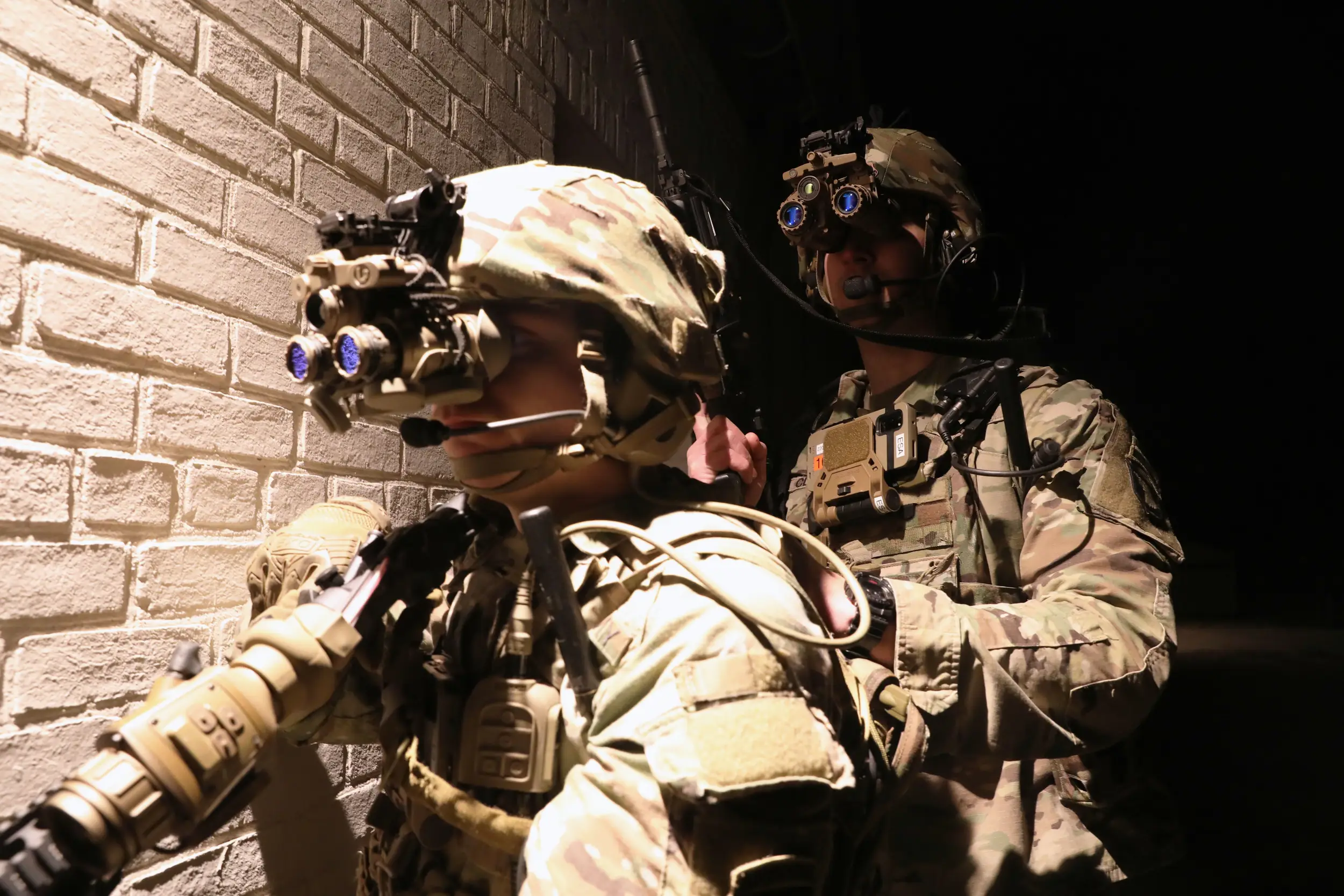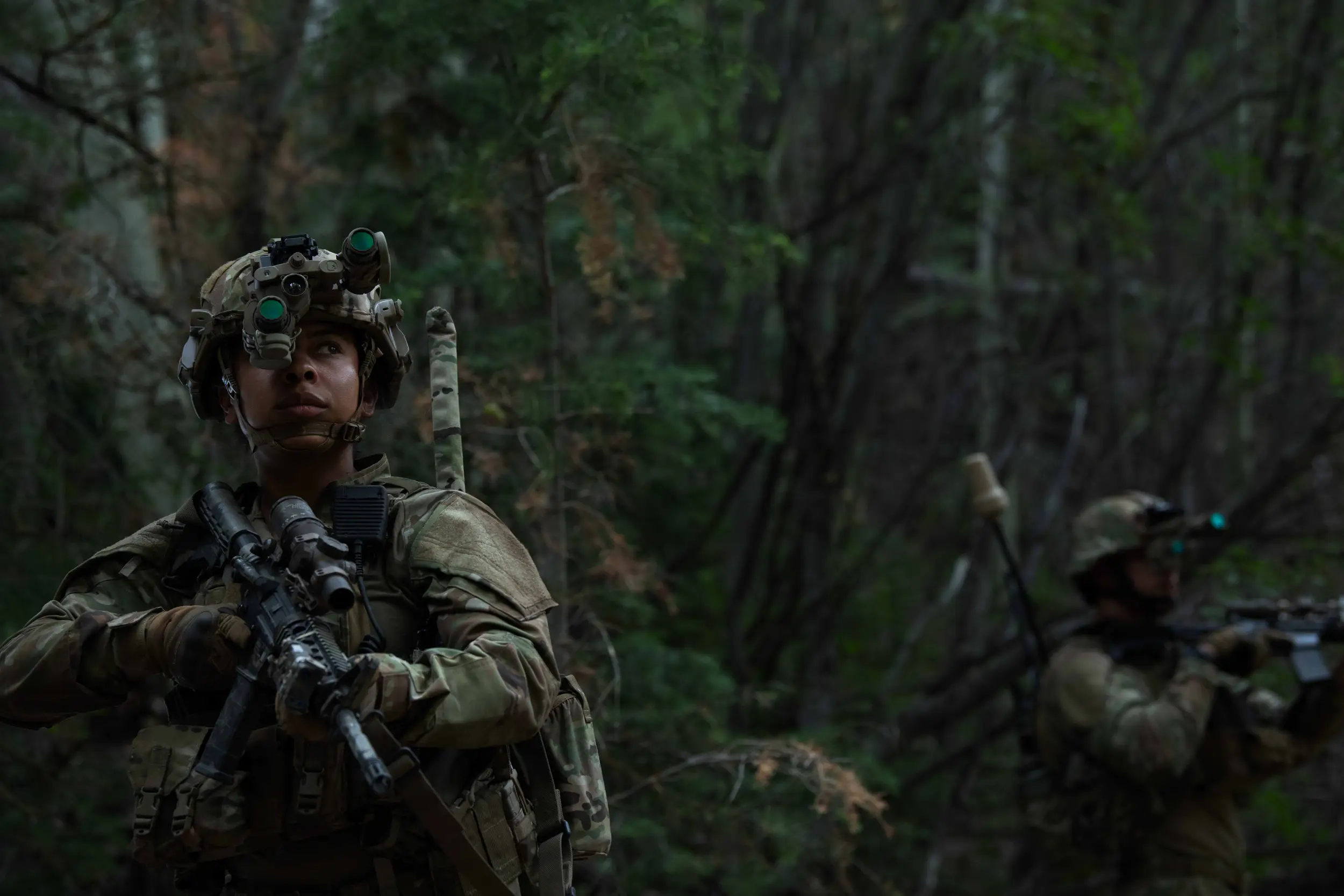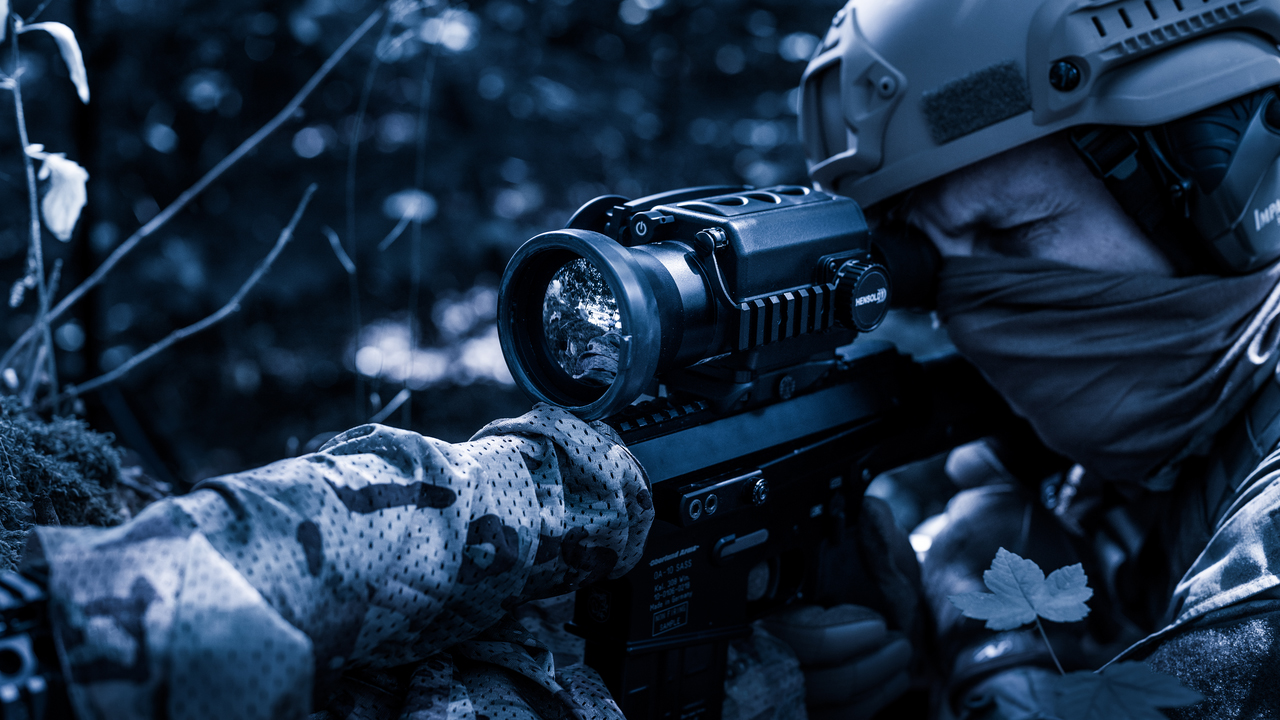
REPORT HOME > Night vision – seeing the full picture
SEPTEMBER 2024 | TECHNOLOGY REPORT | NIGHT VISION AND SITUATIONAL AWARENESS
Night vision systems have been a vital part of military operations for many decades now, but the technology must continuously evolve in today’s challenging threat environment. Shephard examines the work developers are carrying out to enhance NVGs and similar devices, and their role on the future battlefield.
Above: The US Army’s Enhanced Night Vision Google – Binocular (ENVG-B) system is representative of the current state of the art, with early soldier involvement in its testing proving insightful. (Photo: US Army)
Interviewed exclusively for this report, government and industry experts point to evolution in a range of areas, from image intensification to the introduction of augmented reality (AR).
Colonel (P) Phil Kiniery is director of the Soldier Lethality Cross Functional Team within US Army Futures Command, which has worked on and trialled such equipment as the Enhanced Night Vision Google – Binocular (ENVG-B) system.
He told Shephard that night vision technologies have improved in several ways in recent years, notably through the introduction of better image intensification, fused thermal capabilities and the ability to improve situational awareness with AR.
Kiniery also pointed to improvements in the portability of power, but said there is still room for improvement here: ‘We know power demands will continue to increase.’
As their basic function, night vision systems give the user information that is not otherwise easily available in conditions of limited visibility. This gives them a wide range of applications in situational awareness, noted Kiniery, and enables a soldier to make better decisions faster and with greater accuracy.
Recently developed NV frameworks include fully digital options, for example, with fused sensors that accept external feeds, sometimes offering the capacity to exchange information across the network.
‘Current efforts that incorporate small UAS allow soldiers to better understand their environment without putting them in harm’s way,’ Kiniery added. ‘Now they can capture the kind of information or intelligence they once would have had to pursue on foot.’
Gaining user acceptance for worn night vision devices requires a focus on both form and function, he explained, with the goal of making items fit better and perform better for longer periods of time. ‘For SWAP trade-offs, the information soldiers receive must outweigh the inconvenience of weight and form factor, but we have to continue to focus on reducing the soldier’s on-body burden.’
Integration of sensors with legacy enablers will form new systems that enable squad-level situational awareness, he said, instead of just at individual level, ‘thereby functioning as part of a larger enterprise while reducing the burden across the unit. There has been a concerted effort over the last five or so years to include soldiers early in the developmental process to better inform the optimum balance they require.’
For example, soldiers involved in testing of the ENVG-B system highlighted its capabilities such as rapid target acquisition, an ability to passively bring the weapon optic into the goggle, and AR integration of feeds from a soldier’s Nett Warrior end-user device.
Soldiers also praised the system’s ability to fuse white phosphor with its thermal overlay, allowing them to adjust the balance of what they are seeing and fine-tune their night vision capability depending on the specific mission or situation.
Gaining an advantage
Dario Valli, director of sales at L3Harris – which manufactures ENVG-B and a range of other night vision equipment – said there is a continuing focus on ensuring ‘the highest-performing capability in the most extreme low-light conditions, so that we can detect and identify threats and come up with an observe, orient, decide and act (OODA) approach before the adversaries even know we’re there’.
Valli also pointed to a growing focus on combining night vision with other sources of critical information and sensors throughout the battlespace. He noted that the ENVG-B system can stream data from other sources and provide users with an AR view.
Above: L3Harris manufactures ENVG-B and other night vision equipment which can stream data from external sources and provide users with an AR view. (Photo: L3Harris)
There is a need for ‘ease of information right up into their head-worn system, a greater capability of situational awareness and a scalable capability, ensuring warfighters have access to critical information from a variety of sensors, whether unmanned airborne and ground sensors or other command and control systems,’ Valli said.
Michael Gilroy, director of international business development at L3Harris, added that there is growing demand for this kind of increased situational awareness across the global market, delivering capability to the end user. ‘It’s more than just night vision, because everybody has night vision these days, including our adversaries. For us, it’s about making sure that we have overmatch capability against our adversaries.’
He further added that every soldier should have access to night vision equipment, whether in the front line or in rear echelons where there is still a need for mobility, noting that the company offered different solutions for matching those different needs.
Growing capabilities
Hensoldt also manufactures a range of soldier night vision systems, including sights, scopes, attachments, and goggles.
A spokesperson reiterated the growing capabilities of night vision from the company’s perspective, including combined thermal and night vision devices, AR overlays with real-time data such as maps and target locations, and live video feeds from ground vehicles, UAVs and other assets.
They outlined a range of advances in recent years, including development of high-definition sensors and white phosphor technology for ‘clearer, more detailed images’.
The introduction of tubes featuring enhanced sensitivity, auto-gating and filmless designs has also been a notable trend, they added, with high-definition components providing sharper images with better peripheral vision.
‘These innovations, along with hybrid systems that fuse digital sensors with traditional tubes, have significantly improved image quality, durability and operational effectiveness for soldiers in low-light environments.’
Systems are also now more compact, lightweight and durable, often featuring wireless connectivity and smart capabilities to enhance soldiers’ operational effectiveness and safety in night and low-light environments.
Above: Hensoldt supplies night vision systems for soldiers including sights, scopes and attachments with an emphasis on modularity. (Photo: Hensoldt)
‘Modular systems allow customisable configurations and future upgrades, while lightweight materials and miniaturisation reduce weight without compromising durability,’ they said.
Easing the cognitive load
An Elbit Systems spokesperson told Shephard that the company has an ‘overarching goal to alleviate the soldier's cognitive load’, prioritising figure of merit (FOM), a measurement that encompasses factors such as sensitivity, resolution and signal-to-noise ratio.
‘Advancements in image intensifier tubes have resulted in superior FOM NVGs, providing soldiers with a clearer and more detailed view in low-light conditions,’ they added.
Reducing the overall weight of the equipment while maintaining capability is also a major consideration: ‘This translates to reduced strain on the neck and back, improving endurance during long operations.’
Pointing to the need to go beyond night vision alone, the spokesperson said that Elbit aims ‘to maximise situational awareness for dismounted soldiers and other personnel’. This would involve incorporating feeds from other assets – such as C4I data and text – directly into NVG displays, providing a more holistic battlefield picture, enabling faster and more informed decisions.'
Evolving architecture
Matthew Renzi, senior director of engineering at L3Harris, said that modular systems are the future for night vision, providing ‘the flexibility to upgrade the base product over time as technology evolves’. He said this is a key focus for L3Harris, ensuring that ‘our architecture evolves against emerging threats. You can never be 100% on that, but we want to put in as much forethought as possible.’
He continued, ‘You need to think very carefully about what you’re designing in terms of future enhancements that can be added to a product as technology evolves,’ noting that by providing a high-quality system with a long service life this flexibility to upgrade was essential.
Drawing an analogy with the commercial world, Renzi said: ‘Think of it [a night vision device] as your first smartphone versus today’s smartphone. It looks similar, but it’s a very different piece of technology with lots of advancements. And there’s always technological hurdles to developing that capability.’
Gilroy also emphasised the need for an engineering approach that matches this ambition: ‘It’s not just about being flexible with your technology, it’s also about being flexible with your production. And that’s one of the areas we really put a lot of thought into. It’s great to say we have new technology, but if you can’t actually build it and get it out to the field, you’re going to be left behind.’
Above: L3Harris is focused on flexible systems whose architecture can evolve over time to handle emerging threats. (Photo: L3Harris)
The US Army’s Kiniery added that displays will continue to evolve, providing greater resolution while becoming smaller and lighter to be less constraining and more convenient for the user, and micro-LEDs will provide greater field of view without the eye box constraints seen in legacy systems.
‘These devices will evolve into projections in front of the eyes that do not require physical contact with the wearer,’ he said. ‘We anticipate there will be greater integration of systems on the battlefield to provide soldiers with increased situational awareness from other robotic and autonomous systems in their battlespace.’
With progress continuing to be made in areas such as portability, modularity and integration with other sensors and networks, now ubiquitous night vision systems remain an essential and increasingly capable item of equipment for the modern infantry soldier.



